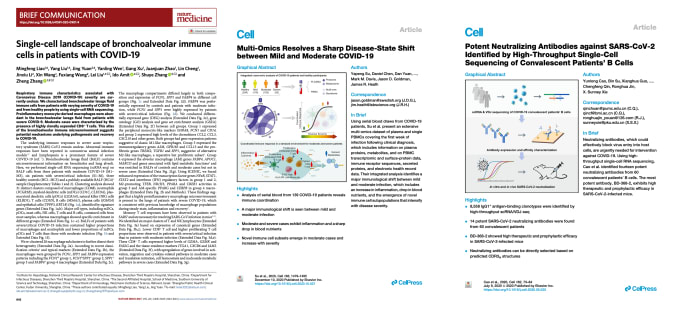The path to a vaccine: looking back on the research that helped us understand COVID-19
Pfizer’s recent announcement of the conclusion of their Phase 3 study of a COVID-19 vaccine candidate and, now, emerging regulatory authorizations that may enable distribution of the vaccine to healthcare workers and at-risk populations, has left many of us feeling hopeful. This news, along with Moderna’s pending vaccine approval, comes like a glimmer of light at the end of a long and dark tunnel. But the path to a vaccine has been marked by other bright spots—fundamental research that has contributed to our holistic knowledge of SARS-CoV-2 infection mechanisms, the cellular and molecular basis of disease severity, and the complex immune responses to infection and therapeutic intervention. Together, these insights have laid the foundation of our understanding of COVID-19, upon which increasingly safe and effective vaccines can be developed.
As 2020 comes to a close, we want to look back at some of these fundamental discoveries and honor the global collaboration and immense scientific effort behind them. Review three key publications in the sections below to learn how single cell immune profiling technology from 10x Genomics accelerated crucial insights into COVID-19 and the host immune response, representing transformative approaches in how we study and understand infectious disease. For more research stories, visit our COVID-19 resources page →

Tracking the immune response to COVID-19 in the lungs
While many cases of COVID-19 resolved after mild to moderate symptoms, for some, the disease took a worse turn, leading to pneumonia and acute respiratory distress syndrome (ARDS). Beyond the impact of lifestyle or pre-existing health conditions, what’s the underlying biological cause of this patient-to-patient variation? Earlier this year, a research team led by Dr. Mingfeng Liao from the Shenzhen Third People’s Hospital in China set out to understand this question. Namely, they wanted to know how the immune system responds to SARS-CoV-2 infection in the lungs and how this response differs between patients with varying disease severity. Leveraging single cell RNA-sequencing (scRNA-seq), they profiled the cellular composition of bronchoalveolar lavage fluid from patients with moderate and severe infection. They identified distinct cellular populations and inflammatory conditions between the two groups. Patients with severe infection had higher proportions of macrophages and neutrophils compared to those with moderate infection; further refinement of macrophage heterogeneity revealed gene expression signatures characteristic of a highly proinflammatory macrophage microenvironment. Severe patients also had lower CD8+ T-cell proportions.
Moreover, single cell T-cell receptor sequencing (scTCR-seq) revealed a high proportion of clonally expanded ZNF683+ CD8+ T cells in samples from patients with moderate infection. These expanded T cells also had heightened expression of tissue-resident genes, suggesting they represented SARS-CoV-2-specific CD8+ T cells equipped and ready to clear out infected cells in local lung tissues (1). These insights into the cellular dynamics of local infection pointed to the role of an uncontrolled, highly inflammatory innate immune response, contrasted by a robust adaptive immune response, in tipping the scales of COVID-19 severity.
A holistic view of COVID-19 immunopathology reveals insights for treatment
Local infection is only one of the many factors that contribute to disease severity. Thus, as scientists verified the dynamics of innate and adaptive immune cells in the lungs, others began investigating the systemic immune response. How do immune cell populations change throughout the body? How do they coordinate with one another and how does this contribute to disease severity and prognosis? To understand the holistic immune landscape in response to COVID-19, researchers led by Dr. Yapeng Su from the Institute for Systems Biology in Seattle, WA analyzed serial blood draws from 139 COVID-19 patients collected in the first week of infection and representing the full range of disease severity. Their approach leveraged single cell immune profiling and Feature Barcode technology from 10x Genomics to develop a comprehensive view of immune cell characteristics, including a readout of whole transcriptome gene expression, 192 surface proteins, and T-cell and B-cell receptor sequences at single cell resolution.
Their analysis revealed striking differences in immune cell populations between mild and moderate infection, as well as unique immune cell states. Moderate infection was marked by an increase in CD8+ T-cell populations expressing a hybrid of proliferation, exhaustion, and cytotoxicity signatures; moreover, there was a noted expansion of CD8+ clones with a cytotoxic effector phenotype, suggesting increased virus–antigen encounters at the moderate stage of infection severity. Interestingly, they identified two unusual CD4+ T-cell subpopulations in this stage that also exhibited a proliferative exhausted phenotype and a clonally expanded phenotype, respectively. Other adaptive immune cells showed unique features: B cells taken from moderate and severe patient samples showed downregulation of several HLA class II genes and loss of chemokine receptors CXCR5 and CCR6, pointing to possible causes of dysregulation in immune cell crosstalk and humoral immunity in these stages of disease. The emergence of expanded monocyte populations, and accompanying increase of certain plasma proteins previously associated with COVID-19 severity, further distinguished moderate from mild infection. This data pointed to a role for monocytes in the coordinated immune response for increasingly severe SARS-CoV-2 infections and indicated plasma proteins as potential biomarkers of dysfunctional monocyte activity (2).
The cellular and molecular insights from this integrated view of the immune response to COVID-19 across a large patient cohort helped the research team conclude that therapeutic interventions at the stage of moderate severity would likely be most effective. And they demonstrate a powerful heuristic to evaluate the heterogeneity of COVID-19 disease manifestation and predict patient prognosis.
Accelerating antibody discovery for COVID-19 therapies
Humoral immunity is another crucial feature of the holistic immune response to infection, as antibodies specific to viral particles can facilitate their destruction by other immune cells. This led Dr. Yunlong Cao and a research team from Peking University to search for neutralizing monoclonal antibodies (mAbs) against SARS-CoV-2 in memory B cells isolated from convalescent patients’ plasma. The authors performed magnetic bead separation to select for antigen-binding B cells, specific to the characteristic SARS-CoV-2 receptor-binding domain (RBD) and spike (S) proteins, from the PBMCs of a total of 60 convalescent patients. Then they leveraged high-throughput single cell RNA- and VDJ-sequencing of antigen-binding B cells to characterize 8,558 distinct IgG1-presenting antigen-binding clonotypes. Further screening filtered out clonotypes that were less likely to yield mAbs—for example, B cells with a somatic hypermutation rate less than 2% were excluded—resulting in a panel of 169 prospective neutralizing antibody candidates. With the full-length, paired VDJ sequence, they accelerated their screening to produce recombinant antibodies, which were then tested for SARS-CoV-2 RBD/spike reactivity by ELISA. These tests uncovered 14 potent SARS-CoV-2 neutralizing antibodies, one of which was shown to have high preventative and therapeutic efficacy in mice (3). These results point to an effective model for rapid antibody discovery, all the more important in light of the urgent need for therapeutic and prophylactic interventions against COVID-19.
Fundamental research drives the fight against COVID-19
The dedication of many scientists searching for basic cellular and molecular insights into the mechanisms of COVID-19 infection and the host immune response has taken us far in our understanding of this disease. Now, we have insights into the complex coordination of innate and adaptive immune populations across stages of disease severity that can inform treatment and therapeutic development; new biomarkers to support prognostic decisions; and viable antibody therapeutic options. Supporting these studies, single cell multiomic tools have emerged as a new, accelerated approach to infectious disease research that will continue to drive crucial insights into pathogens and the diseases they cause.
To learn more about the applications of single cell and spatial multiomics to infectious disease research, explore these resources.
Finally, thank you to the many researchers, doctors, and patients who have made these studies possible. We wouldn’t be here without you.
References:
- M Liao et al., Single-cell landscape of bronchoalveolar immune cells in patients with COVID-19. Nat Med. 26, 842–844 (2020)
- Y Su et al., Multi-Omics Resolves a Sharp Disease-State Shift between Mild and Moderate COVID-19. Cell. 183 (6), 1479–1495.E20 (2020).
- Y Cao et al., Potent Neutralizing Antibodies against SARS-CoV-2 Identified by High-Throughput Single-Cell Sequencing of Convalescent Patients’ B Cells. Cell. 182 (1), 73–84.E16 (2020).
